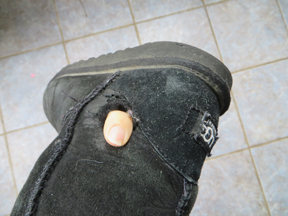chewed shoe DeGioia

Leaving things on the floor where the dog or puppy can reach it gives the dog easy access to things to chew. Photo by VIN
Destructive chewing is a common problem in puppies and adult dogs.
Chewing by puppies is a natural, normal behavior. Puppies chew because they’re teething, they're playing, they're learning about their environment, they’re trying to escape from their kennel, etc.
One of the main ways puppies learn about their world is to put things in their mouths and chew on them. It is unlikely that you will be able to stop normal chewing behavior completely in puppies. Trying to stop a normal but unwanted behavior can cause stress and anxiety, and lead to more serious behavior problems.
Teething occurs in puppies up to eight months of age. That means chewing problems can be worse in younger animals than in older ones.
Adult dogs may be destructive chewers because they have separation anxiety, they're playing, they’re hungry, they don’t get enough exercise, they weren’t properly trained as puppies, etc.
How can you minimize the damage to your home and household?
The basic methods are to keep your puppy/dog busy, prevent access to things that you don't want damaged, and provide your pet with acceptable things to chew.
- Keep your dog busy. Exercise, fun, reward-based training sessions, playtime, feeding from food dispensing toys rather than bowls, etc., allow your dog to use her brain and muscles.
- Dog proof your house. In other words, keeping things (clothes, children’s toys, small objects, etc.) that can be destroyed off the floor and out of the dog's reach. Keep closets, drawers, and toy boxes closed. Take objects off of any surface the dog can reach.
- Supervise your dog. If there are times you cannot watch the dog while she’s running loose in the house, put her in a secure area (dog kennel, crate, enclosed room, etc.) or leash her to your belt. If you decide to use a kennel or crate, you’ll have to acclimatize her to it or she may develop other behavior problems.
- If there are items that you cannot prevent your dog from having access to, you may decide to try deterrents, such as making the area around the object unpleasant (plastic rug runners or motion/vibration detectors).
- If you catch your dog chewing an inappropriate object, don't scare her or try to punish her. Use the treat-in-trade method by offering her a treat or something else worth trading for; when the pup is clearly invested in the new item, pick up the discarded one. With swapping, the pup will not fear an owner's approach when she has something she values because the owner's approach is generally associated with getting something better! Start using this technique early in her training and encourage swapping for lots of items so that she can learn the technique and will learn to readily give up even a highly prized object. It's always better to reinforce positive behavior than to punish your pet because punishment can cause anxiety and other undesirable behaviors to develop. Dr Sophia Yin's book Perfect Puppy in 7 days has more training tips.
- Provide plenty of acceptable chew toys. What is acceptable depends on the size of your dog, what she finds appealing, etc. Many items have been commonly used (large bones, rawhide chews, plastic bones, hooves, Kong toys, rubber toys, puzzle/foraging toys, dental treats, and so on). However, some are no longer as acceptable as they once were. Cattle hooves, sterilized large bones, plastic bones, etc. can damage teeth. Rawhide chews may become choking hazards if the dog isn’t supervised and the rawhide taken away when it becomes small enough to be swallowed. Ask your veterinarian or veterinary dentist for professional preferences on what are safe, acceptable chew toys. Always raise/reward your dog for chewing appropriate things. Remember that toys will be destroyed; that's how you know it's a toy your dog likes.
- Do not give your dog old shoes, clothes, or children's toys for her to chew on. Dogs really can’t tell the difference between those items and your “good” shoes, clothes, etc.
- If an animal is protecting resources and showing aggression, the animal should be avoided when it has those items and should have a veterinary behavior consultation because there may be a more complex problem going on.
- If these things don't help, or if the destructiveness gets worse, consult your veterinarian for help.
Destructive behaviors (chewing, barking, digging, etc.) are not only damaging to your home and possessions, but they can also lead to injury to your dog. Plus, they are a major reason dogs are taken to animal shelters and humane societies. With a little time and work, you and your dog should be able to have a good life together and could avoid being part of those statistics.